 |
|
The Space Launch System (SLS) and Space Transportation System (STS) with Single-Stage-To-Orbit (SSTO) Reusable Launch Vehicle (RLV) Space Shuttle III/BigStar was totally reengineered and ext- ended as the XSS-3 based on the Space Shuttle II, and as such is also nicknamed as the Big Space Shuttle. With our Orbital Space- Plane (OSP) we created the solar system wide most cost-effective, most simplistic and environmental friendliest technologies for space travels and cargo services into the Low Earth Orbit (LEO), the Geo- synchronous/-stationary Transfer Orbit (GTO), and beyond.
With the adaption of our Style of Speed Space System Standard (S5) and Integrated Design Concept (IDC) by the NASA we redefined the U.S.American space program in this area. In this way we have written space history once again.
The Space Shuttle III/BigStar is based on highly reliable and inex- pensive off-the-shelf technologies, which were developed in many projects led and conducted by the NASA, DARPA and U.S. Air Force, as well as by Ontonics™, the OntoLab™ and us from Style of Speed in the fields of:
Space Launch System (SLS),
Space Transportation System (STS),
Single-Stage-To-Orbit (SSTO),
Reusable Launch Vehicle (RLV) with engines of the type
- Rocket (RRLV),
- Air-Augmented Rocket (RAARLV),
- RamRocket (RRRLV),
- RamAerospike (RRALV),
- Air-Breathing Rocket (RABRLV),
- Air-Breathing (RABLV),
- Rocket-Based Combined Cycle (RRBCCLV), and
- RamRocket-Based Combined Cycle (RRRBCCLV),
Orbital Vehicle (OV),
Space Maneuver Vehicle (SMV),
Approach and Landing Test Vehicle (ALTV), and
Orbital Test Vehicle (OTV),
like:
NASA, Rockwell, Boeing and partners STS OV Space Shuttle,
SOS STS RABLV Space Shuttle Next Generation X-3033/MagicStar,
NASA, Lockheed Martin and partners SubOTV X-33,
Lockheed Martin and partners SSTO RRLV VentureStar,
Orbital Sciences, Rockwell and partners RRLV X-34,
Boeing and partners RRLVs
- SMV X-40A,
- ALTV X-37A, and
- OTV X-37B,
NASA SSTO RRBCCLV reference concept GTX/Trailblazer, and
Orbital Sciences RLV X-42.
Integrated Design Concept
Even without making a flight our OSP has already revolutionized how to conquer space by defining the Integrated Design Concept (IDC) that provides a:
complete basic end-to-end system design that is highly optimized and includes
- spacecraft,
- launch vehicles,
- launch services,
- ground operations
- mission operations, and
- reuse or/and recovery,
and a
coherent modular system architecture that enables to
- apply the best practices for services and operations,
- use and reuse the best, and highly to most matured components,
- provide a modular cargo bay, for example, and
- add in the capability for returnable plug-and-play tasks, like experiments and services for our customers.
Style of Speed Space System Standard
With our approach we also defined a basic strategy and concept around the year 2007 that is now called the Style of Speed Space System Standard (S5), and also a defining subset of the Space Launch System Architecture, which includes as a main element the recycling of technologies and components of the STS Space Shuttle Mark 1 and 2, and the X-33/VentureStar program, of which most to mention are the:
bipropellant based on the combination of cryogenic hydrogen and oxygen,
composite tank,
rocket engines of the types
- RS-25D/E, as used on the Space Shuttle Mark 2 orbiter, and better known as the Space Shuttle Main Engine (SSME), and revived and developed further with our SXME-2200 aerospike engine, and
- J-2S/X, as used on the X-33 suborbiter, and also revived and developed further with our aerospike engine RX-2200,
control software of the STS Space Shuttle Mark 2,
further useful elements that fit for a special typ of spacecraft, like
- composite structures, as used on the SubOTV X-33, and
- life support system, as used on the Space Shuttle Mark 2.
Technology Readiness Level
Our Space Shuttle III/BigStar is besides the OTV X-37B one of the only two Orbital SpacePlanes (OSP), and the only OSP for human transport in existence with a Technology Readiness Level (TRL) of 9 for all system components, that is even the only one with the cap- ability to transport human beings beyond the Low Earth Orbit.
In the case of the BigStar only the integrating part of the system components itself has a TRL of 5, but only due to the single reason that it has not been put into practice. The applied high-tech con- struction processes of the integrating part have all a TRL of 9, too. This highest level of quality was even established just right from its start by design due to applying our S5 and in this way using highly matured components.
The same holds for all ground and mission services and operations.
Single-Stage-To-Orbit System
The Space Shuttle III/BigStar is designed for flights into Low Earth Orbit (LEO) and Geosynchronous/-stationary Transfer Orbit (GTO) by the same system operation as the Space Shuttle. The main differ- ences among the Space Shuttle II and Space Shuttle III are, that:
the architecture of the BigStar is a SSTO STS and SLS, and
the whole spaceplane can be integrated and prepared in a horiz- ontal position and then either:
- turned up in the vertical for the launch, like it was intended with the SubOTV X-33 and SSTO RRLV VentureStar,
or alternatively
- loaded with some less payload for becoming even a Horizontal Take-off and Horizontal Landing (HTHL) spacecraft.
And the next version, the Space Shuttle IV, is already research and designed to be a HTHL spaceplane with the capability to start and land from every major airport with a runway for superjumbos.
Very Cost Effectiveness in Detail
In detail, the very cost effectiveness of our solution for flights into LEO and GTO is achieved by several reasons:
Despite of the overall concept and some new materials, technolo- gies and components invented by us, the foundational concepts and components of the SSTO system are based on available and highly matured off-the-shelf or in government-sponsored projects develop- ed technologies. This can be seen best with our Double Bubble Lift- ing Body (DBLB) fuselage made out of two Space Shuttle Mark 2 mid fuselages inclusive their empennages with shortened vertical stabiliz- ers and rudders that are united at the front with a scaled X-33, the wings of the Space Shuttle Mark 2, and our High Performance Aero- spike™ rocket engine RX-2200 based on the XRS-2200 and RS-2200 aerospike engines of the X-33/VentureStar and the J-2X rocket eng- ine of the Constellation programs, for example.
Also interesting to mention is the fact, that we have taken a lifting body as the uniting element of the two mid fuselages, because simp- ly explained this lifting body needs only to be pushed forward for fly- ing on its own, and in this way creates nearly no additional forces on the whole recycled structures, so that as an implication the devel- opment of new wings, or special exotic and expensive enhancements for the connection of the three fuselage elements is obsolete. This is all standard aircraft construction.
For an optimal aerodynamic performance we've developed a new series of Glassy™ materials for the next generation of glass cockpits and cabins, our Glassy Cockpit™ and Glassy Cabin™ solutions, that we could also integrate with our Thermal Protection System (TPS) on the upper side of the spacecraft.
Our DBLB design of fuselages reduces substantially the consumpt- ion of propellants.
The DBLB fuselage is also designed in such a way that many diff- erent drivetrain concepts can be used, like aerospike engines, that all have altitude-compensating designs.
We have also chosen our DBLB design so that we could substitute the original fuel tanks of the X-33/VentureStar design by cylindric shaped composite fuel tanks. As the result we made it possible to optimally use the space inside the craft and to drop drastically the weight of the whole spaceplane. By all these measures and their yielding effects the overall costs of the system was also lowered by an astonishing scale. All of these optimizations with their advantages were not possible with the design of the original RRLVs X-33 and VentureStar, which also has led to the situation that the financing of their constructions failed. But times have changed, and we from Style of Speed have changed the game.
In the atmosphere, the DBLB augments the flight control with ae- rodynamic control surfaces, while in space it will use the matured, modernized and optimized thruster-based reaction control systems and maneuvering system of the Space Shuttle Mark 2.
A Metallic Thermal Protection System (TPS) with Tricky Pattern™ positioning is applied that drastically reduce the cost of manufact- uring and maintenance of the TPS by around 75%.
Larger tiles of the TPS at the underside of the OSP are used at those positions where tiles with a more complex shape are unavoid- able.
A Carbon Carbon nose cap was designed with a geometry that can be manufactured efficiently.
The leading edges of the wings and the shorten vertical stabilizers are made out of some few Carbon Carbon elements that can be ma- nufactured efficiently as well.
Due to the fact that the free stream air and its changing velocity acts as a variable area-ratio nozzle aerospike engines with their alt- itude-compensating feature can be used, which work optimally in all altitudes. In this way the usage of a simple gas generator cycle sy- stem is applicable that reach or even surpasses performance levels of engines with closed staged combustion cycle architectures. The aerospike nozzle fills the base portion of the vehicle thereby reduc- ing the so-called base drag, which generally occurs when the slip- stream behind a vehicle does not reconverge immediately. The spec- ial shape of our DBLB fuselage supports both effects even more in a perfect harmony.
Our High Performance Aerospike™ rocket engines are constructed by following a design philosophy that is based on a highly reduced overall system complexity, using off-the-shelf components, if possib- le taken from eg. business jets, and applying industry standard mat- erials with efficient fabrication processing techniques, for example for the altitude-compensating expansion surfaces. Our aerospike engines are also constructed by heightening their safety and envir- onmental friendliness. All measures are low-cost but highly reliable, which also drastically reduce the cost of manufacturing and main- tenance of the drivetrains by around 80% in the beginning to 94% in the later production phase.
One representative example for this design philosophy is our liquid aerospike engine RX-2200 that is based on the aerospike engines XRS-2200 and RS-2200 by Rocketdyne with our optimization of the PowerPack Assembly (PPA) that we customized by recycling the gas generator of the rocket engine J-2X. And for sure, this turbopump recycling also saves money.
Using the gas generator system also eliminates the extra weight of a staged combustion system whose high-pressure operations require heavier, more costly components due the extreme turbine conditions, the requirement of highly specialized plumbing to carry the hot gas- es, and the necessity of a very elaborated feedback and control de- sign.
Normally, the end of an aerospike engine is truncated for weight reduction. On the one hand this heightens the performance, but on the other hand the performance is lowered by creating a base drag in this way again. It is also standard that in a gas generator system of a rocket engine some propellant is burned at low-performance conditions to run the turbopump. But instead than recirculating and burning the turbine exhaust gases, as it is done with the staged combustion rocket architecture of for example the Space Shuttle Main Engine, or simply dumping the exhaust, as do most other bell- nozzle engines, the aerospike engine RX-2200 is also cleverly design- ed in such a way that it exhaust gases through the truncated end of the spike for creating additional thrust, and elevating the pressure in that region, so that some of the performance loss associated with the base drag is compensated.
As the overall result a substantially lower propellant consumption (theoretically of up to 35%), which is especially made in the first phase of a launch, but also a higher performance, and by this an always appreciated weight reduction of an aerospace vehicle can be achieved.
Due to their linear geometry our High Performance Aerospike eng- ines are not limited by the square-cube law, and can be mounted in a rectangular array. This makes possible our own development of a modular drivetrain system that can be configured after the needs of a mission, rather then building a whole new specialized spacecraft.
The flight control of theSpace Shuttle III is done by varying the thrust from side to side and engine to engine, and by the support of the rudders in the vertical stabilizers. By throttling the upper and lower thrust cell banks, or appropriated combinations of the single twin engines the differential thrust for the steering, pitch, roll, and yaw of the Space Shuttle III/BigStar is controlled. To generate the necessary moments, the Space Shuttle III has six or seven twin linear aerospike engines each with two thrust cells. Additionally, in this way no gimbals are needed by the aerospike engine to direct rocket thrust, so that it can simply be rigidly mounted to the already existing airframe of the mid fuselage of the Space Shuttle Mark 2.
Without a complex construction, as well as systems for thrust vect- oring by using gimbals, hydraulics, and flex lines reduces the weight, and makes our aerospike engine easier to maintain than conventional rocket engines, for example.
We also have taken a closer look at some technologies that will in- crease the overall performance of our OSPs and AeroSpacePlanes (ASP) even further by around 20%.
All of the described optimizations have had positive effects to the dimensions of the spaceplane, which means that it has been con- structed as a small, lightweight and very high performing vehicle.
But our OSP also reduces substantially the cost of safeness as well, because of its fundamental system design. For example: If one rocket engine doesn't run, then the opposite engine can be shut off while the remaining working engines can be throttled up to compen- sate and counterbalance the failed thrust. And due to the ballistic trajectory of the Space Shuttle III/BigStar the spaceplane simply glides back to Earth, if the whole aerospike engine fails during flight.
The fundamental design concept of our spaceplane also reduces significantly the complexity of the turnaround cycle. Standard main- tenance work and eventually needed repairs of the vehicle after a flight, and preparing it for a new launch can be conducted in an un- precedented timely and cost-effective manner. This is as well a re- sult of the horizontal preparation and integration strategy, but also of the application of the Metallic TPS and the aerospike engine, for example.
And a further aspect is often forgotten in conjunction with space launch systems: The cost of a rocket launch site or spaceport. With our SSTO system you can use a normal runway for landing, as every major airport has.
Images

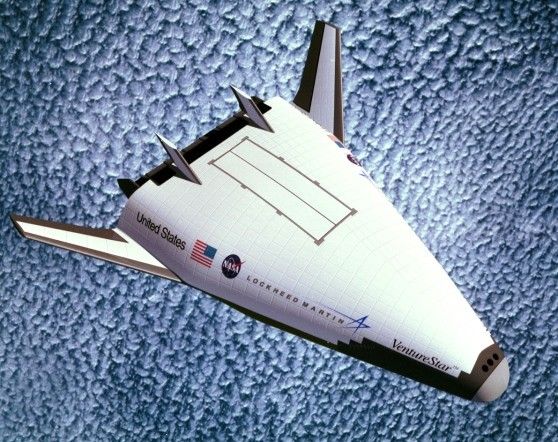 
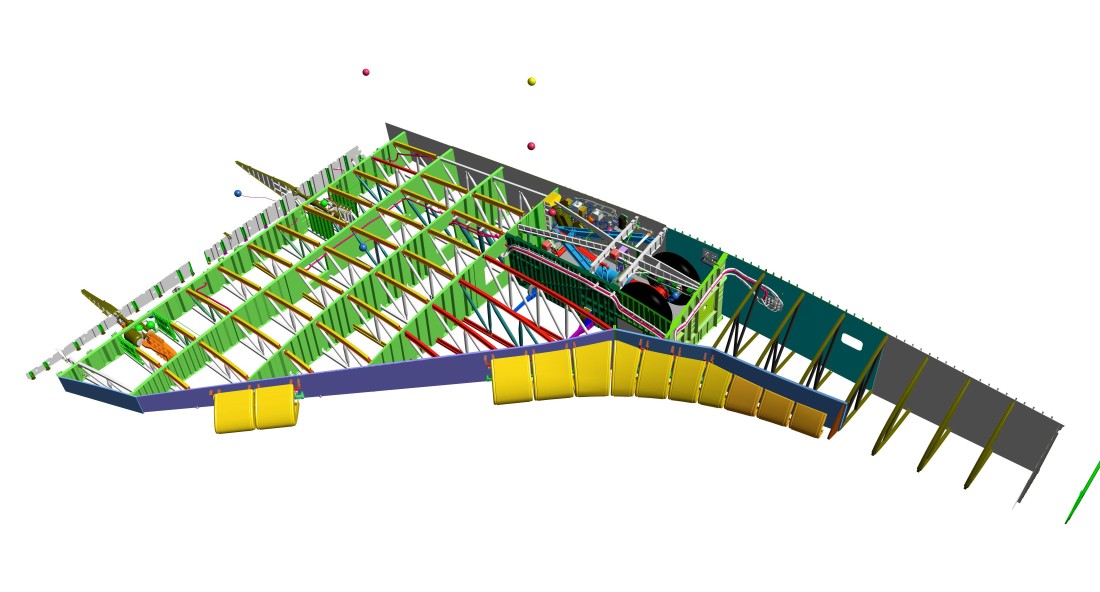 
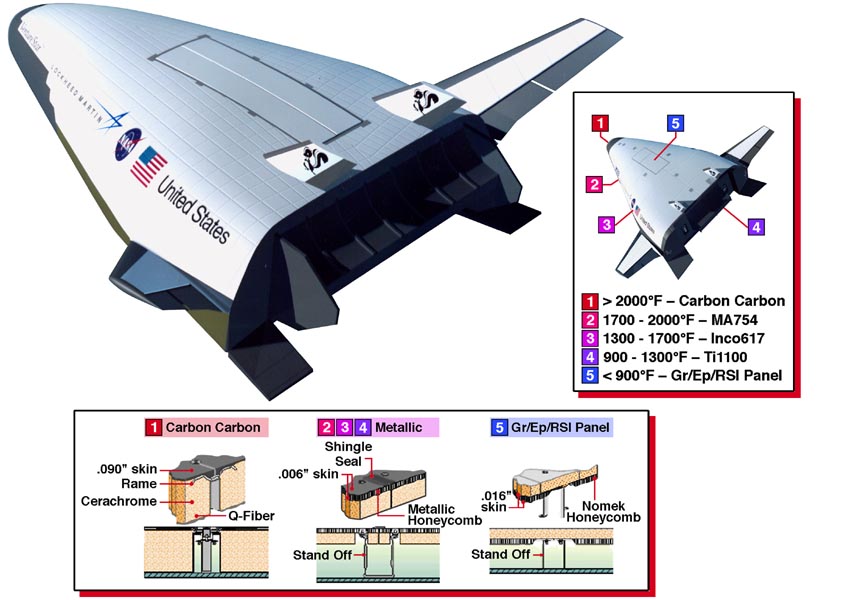 
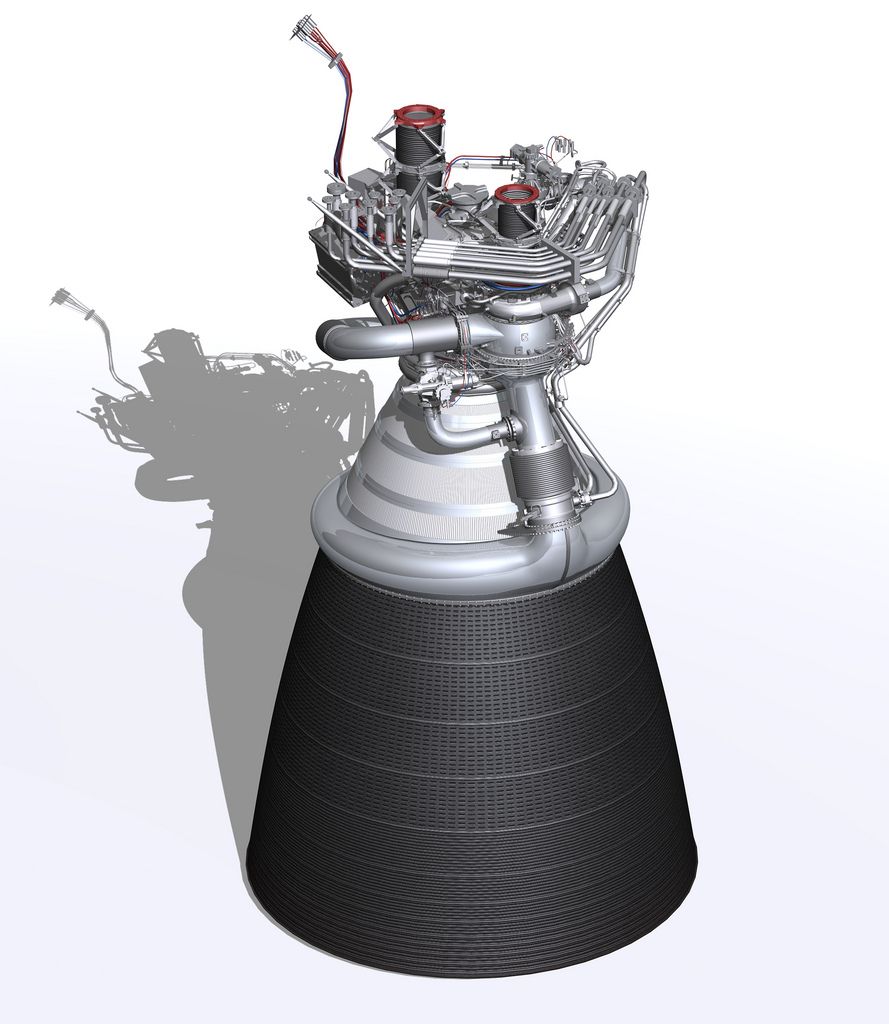 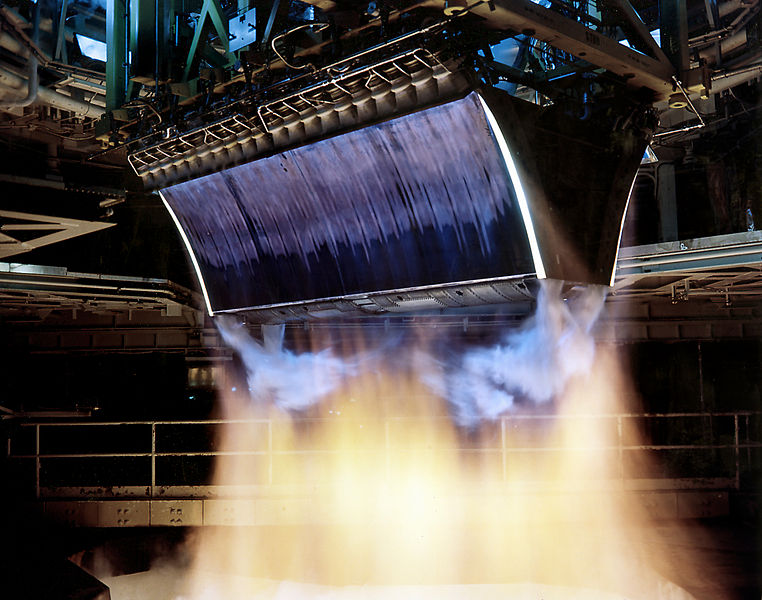
Specification
Design exterior: Style of Speed, NASA, Rockwell, Lockheed Martin, Boeing, Pratt & Whitney, and their partners
Design interior: Style of Speed, NASA and partners
Stages: 1
Engine:
- 6× RX-2200 Twin Linear High Performance Aerospikes™,
12 thrust cells, 3× left, 3× right, or
- 7× RX-2200 Twin Linear High Performance Aerospikes™,
14 thrust cells, 3× left, 1× center, 3× right,
with optional
- Twin Linear Air-augmented Aerospike/RamAerospike™
6× RX-2200
Thrust at sea level: 14,501,331 N/3,260,029 lbf
Thrust in vacuum: 16,656,000 N/3,744,418 lbf
Length: 55.78 m/183 ft
Wingspan: 30.18 m/99 ft
Height: 14.94 m/49 ft
Mass: 1,090,000 kg/2,403,014 lb
Vmax: Mach 28 at 64,000 m/210,000 ft
Service ceiling: 1,000 km/621.4 mi
Payload to LEO: 25,000 kg/55,115 lb
Payload to GTO: 4,536 kg/10,000 lb
Payload to PolO: 13,320 kg/29,365 lb
7× RX-2200
Thrust at sea level: 16,918,220 N/3,803,367 lbf
Thrust in vacuum: 19,432,000 N/4,368,487 lbf
Length: 60.05 m/197 ft
Wingspan: 32.92 m/108 ft
Height: 14.94 m/49 ft
Mass: 1,124,000 kg/2,477,970 lb
Vmax: Mach 28 at 64,000 m/210,000 ft
Service ceiling: 1,000 km/621.4 mi
Payload to LEO: 35,000 kg/77,161 lb
Payload to GTO: 6,350 kg/14,000 lb
Payload to PolO: 18,648 kg/41,111 lb
Versions
The Space Shuttle III/BigStar is also deliverable as:
Low Earth Orbit (LEO) AirLiner (LEOAL),
Fly-back Booster Launcher (FBL) in a Two-Stage-To-Orbit (TSTO) configuration based on our Hypersonic AirLiner (HAL) HAL-1/Hyper Star due to the same architecture,
Geosynchronous/-stationary Transfer Orbit (GTO) transporter of Space Taxis™, like our X-3*™/LittleStar™, or smaller OSPs, like the X-37 by the NASA, Boeing and the United States Air Force, and
GeoSynchronous Orbit (GSO) AirLiner (GSOAL) and Geostationary Earth Orbit (GEO) AirLiner (GEOAL).
Further Informations
Custom specific configurations are available on special request.
That's how our partners together with us from Style of Speed are conquering space:
Straight Superior Strong
|
|
|










